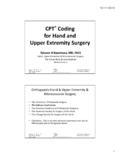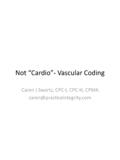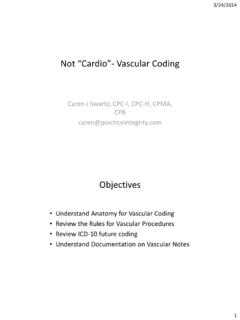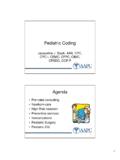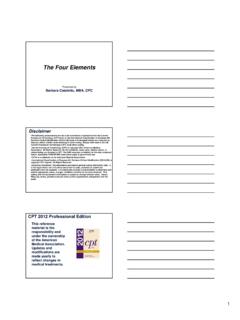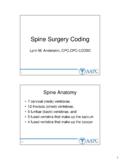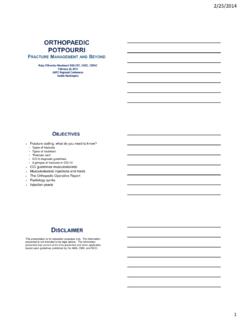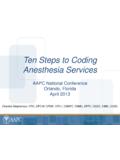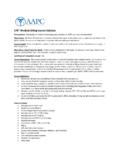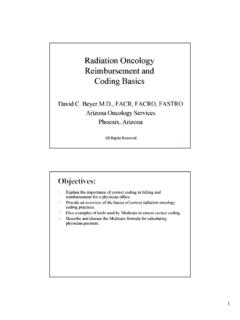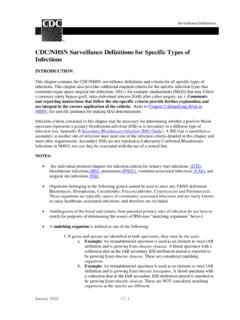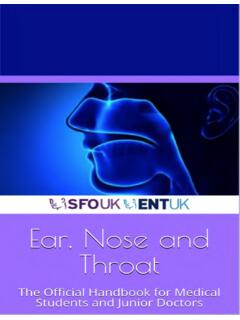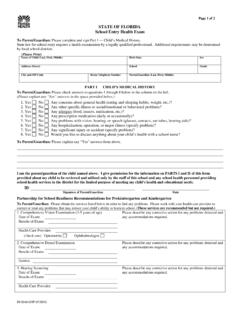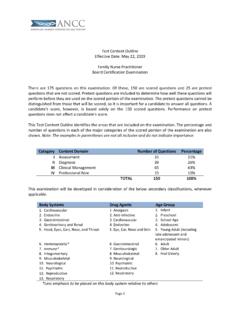Transcription of Evaluation and Management Coding for Emergency …
1 Evaluation and Management Coding for Emergency Medicine By Sarah Todt RN, CPC, CEDC. 1. Emergency Department Evaluation and Management Codes 99281. 99282. 99283. 99284. 99285. Critical Care 99291. +99292. 2. 1. ED Evaluation & Management Codes There are three key components that must be met to correctly assign an Evaluation and Management code: History Exam Medical M di l D Decision i i Making M ki 3. CPT E/M Components Other Nature of the presenting problem 99283 vs. 99284. Time Critical Care 4. 2. Medical decision making di t t the dictates th highest hi h t level l l code d that can be chosen . Proper documentation s pports your supports o r choice 5. Medical Decision Making 6. 3. Levels of Medical Decision Making Straight Forward 99281. Low Complexity 99282. Moderate Complexity 99283 and 99284.
2 High Complexity 99285. 7. DOCUMENTATION OF MEDICAL. DECISION MAKING. The number of possible diagnoses that must be considered Chest pain patient Diff Dx chest pain: Angina, PTx, PTx, GERD. Final Diagnosis GERD. The type of Management options Rx drug Management , IV fluids, parenteral narcotics The amount and/or complexity of information that must be obtained, reviewed, and analyzed Labs, X- X-rays, EKGs, Medical records reviewed 8. 4. Medical Decision Making Scoring Systems Most use the Marshfield Clinic Type Audit Tool to expand on the Documentation Guidelines Not an official part of the DGs Tool used to score the overall Medical Decision Making E al ates 3 components: Evaluates components Number of Diagnosis and Management Options Amount and Complexity of Data Risk 9. Medical Decision Making: Number of Diagnosis or Management Options C does CPT d not distinguish di i i h between b new and d established patients in the ED.
3 New problem no additional Work up Patient seen and discharged New problem with additional Work up Admit, Transfer, OR, . 10. 5. Medical Decision Making: Amount or Complexity of Data Review and/order clinical lab test 1 point Review and/order radiology test 1 point Review and/order medicine test 1 point Discussion of test results with performing physician 1. point Decision to obtain old records and/or history from someone other than the patient 1 point Review and summarization of old records or obtaining history from someone else or discussion of case with another health provider 2 points Independent visualization of image, tracing, or specimen 2 points 11. Risk The third part of the overall Medical decision Making The Risk Table is an official part of CMS. Documentation Guidelines Is scored independently Along with Management Options and Amount and C.
4 Complexity l i off Data D. Highest level of risk in any category determines the overall risk score 12. 6. Risk Table Risk of complications and/or Morbidity or Mortality Highest Level In Any Category Prevails 99281 99292 99283 99284 99285. MINIMAL LOW MODERATE HIGH. Suture removal OTC med only; Rx Management ; Abrupt neuro change;. (placed at other acute uncomplicated Acute illness with Potential life facility) injury or illness systemic symptoms; threatening illness;. Acute complicated injury; Severe exacerbation Exacerbation of chronic of chronic illness;. condition Medications requiring monitoring;. i i Parenteral controlled medications 13. Scoring MDM. Must Meet 2 out of 3. Mgt. Data Risk Overall ED E/M. Options p MDM Supported ------- 1 pt. Minimal Straight 99281. forward ------- 2 pts.
5 Low Low 99282. Complexity New pt/ no 3 pts. Moderate Moderate 99283 and Add'l w/u Complexity 99284. New pt 4 pts. High High 99285. with add'l Complexity w/u 14. 7. CPT Specific Rules 15. Nature of The Presenting Problem 16. 8. Nature of Presenting Problem 99281 Usually, the presenting problem(s). bl ( ) are self lf limited li it d or minor i 99282 Usually, the presenting problem(s) are of low to moderate severity 99283 Usually, the presenting problem(s) are of moderate severity 17. Nature of Presenting Problem 99284 Usually, the presenting problem(s). are of high severity, and require urgent Evaluation by the physician but do not pose an immediate significant threat to life or physiologic function. 99285 Usually, the presenting problem(s). are of high severity and pose an immediate significant threat to life of physiologic function.
6 18. 9. Level III: General comments Moderate presenting problem but not requiring urgent Evaluation Prescription Drug Management Includes Rx meds given in ED. Eye drops, ear drops, Antibiotics, pain meds Limited diagnostic studies Single X- X-ray 19. Level III: General comments Systemic symptoms Viral illness Mild exacerbation of chronic condition Recurrent condition 20. 10. Level IV: General Comments Urgent Tx of condition Multiple diagnostic studies Special studies alone (CT, MRI,US). ED Interventions: Nebs Parenteral medications Usually not admitted 21. Level V: General Comments Many Admissions Frequently Involve: Prolonged services in ED. Special Studies with other tests tests--(CT/MRI/US). Multiple reassessments Interpretations of EKG or x- x-rays Old record review Documented conversations 22.
7 11. HISTORY. 23. History The history portion of a patient patient'ss chart includes some or all of the following elements: Chief complaint (CC). History y of p present illness (HPI). ( ). Review of systems (ROS). Past, family and/or social history (PFS). 24. 12. History of Present Illness Location-left sided chest pain, upper, lower, Location- posterior Context while shoveling snow, while cutting a roll, during the football game, scratched by the cat Q lit sharp Quality h chest h t pain, i throbbing th bbi headache, crampy belly pain Timing worse at night, daily, constant, frequent 25. History of Present Illness Severity moderate chest pain pain, 6 out of 10. Duration--10 minutes, for a week Duration Modifying Factors . Factors worse with exertion, unrelieved by Tylenol Associated Signs and Symptoms- Symptoms- diaphoresis, fever, vomiting 26.
8 13. History of Present Illness HPI flushes out the chief complaint in greater t ddetail t il There are two types of HPI identified for the purpose of Coding A brief HPI consists of 1-3 elements (99281--99283). (99281. An extended HPI consists of at least 4. elements (99284. (99284--99285). 27. HPI Examples: Brief-- 32 year old male with left shoulder Brief injury, occurred 4 hours ago Extended-45 year old female with left Extended- sided, sharp chest pain for 30 minutes with left arm numbness and diaphoresis. The pain is worse with exertion 28. 14. HPI Examples Multiple Modifying Elements Child with Chief Complaint of fever: 4 hours of fever, with moderate vomiting, vomiting, diaphoresis that is worse at night, night, right lower quadrant abdominal pain pain,, unrelieved by Tylenol 29.))
9 Review of Systems (ROS). An inventory of body systems Patient's positive responses and pertinent negatives should be documented . For the remaining systems, a notation indicating all other systems are negative is permissible . CMS 1995 Documentation Guidelines 30. 15. Review of Systems (14). Allergic/Immunologic Genitourinary Cardiovascular Hematologic/Lymph. g / y p Constitutional Integumentary Symptoms Musculoskeletal Ears, nose , Mouth, Neurological throat Psychiatric Endocrine Respiratory Eye Gastrointestinal 31. Review of Systems (ROS). Approblem ppertinent ROS addresses 1. system (99282/99283). An extended ROS addresses 2- 2-9 body systems (99284). A complete ROS addresses at least 10. organ systems (99285). 32. 16. Past, Family, Social History (PFS). Past History - A review of the patient's past experiences with illnesses, injuries, treatments treatments,, past hospitalizations, surgeries, medications, allergies, immunizations Family History - A review of medical events in the patient's family with regard to chronic illness, cause of death or diseases related to the current compaint death, Social History - An age appropriate review of past and current activities such as drug and alcohol use, living situation, and job history 33.
10 Past, Family, Social History (PFS). There are two types of PFS in Emergency department Coding . Coding A pertinent PFS consists of any 1. element from the PFS (99281- (99281- 99284). A complete l t PFS consists i t off one element from 2 of the 3 PFS history areas for ED E/M codes (99285). 34. 17. History Issues ROS and PFSH may be recorded by others The provider must reference the elements ROS not as easy to obtain from NNs No need to record things in more than one place ROS elements may be documented in the HPI. A chief complaint will generally include at least one ROS. Chest pain associated with nausea and vomiting HPI element for associated signs/. signs/sxs sxs GI ROS element Same statement may not satisfy multiple sub sub--elements of HPI or ROS. Chest pain since this morning can not be both timing and duration 35.)
